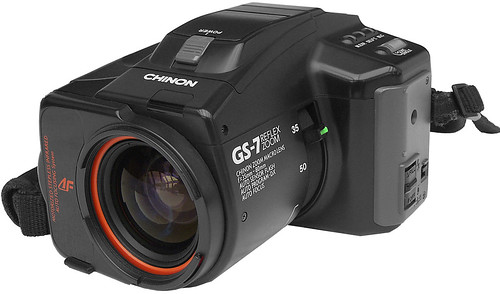Difference between revisions of "Bridge camera"
m (AiBorg - AwCam said "just plain odd" !!!) |
|||
| Line 12: | Line 12: | ||
|- | |- | ||
| | | | ||
| − | + | ||
| − | |||
| − | |||
| − | |||
| − | |||
| − | |||
| − | |||
| − | |||
|} | |} | ||
''See the camera-wiki.org category [[:Category:Bridge camera|bridge camera]] for examples of bridge cameras.'' | ''See the camera-wiki.org category [[:Category:Bridge camera|bridge camera]] for examples of bridge cameras.'' | ||
Revision as of 08:23, 24 April 2012
| ||
See the camera-wiki.org category bridge camera for examples of bridge cameras.
The term bridge camera originated around 1989, with 35mm film cameras such as the Yashica Samurai, the Olympus Infinity AZ-300 Superzoom, and the Chinon Genesis. These were often autofocus single lens reflex cameras including a built-in, non-interchangeable zoom of high specification. Their styling was often highly unusual, an attempt to avoid the associations some consumers felt towards conventional SLRs, perceived as being too difficult and complex. Thus they represented a "bridge" between the ease of use of sophisticated point & shoot compact cameras, but with some of the image-quality advantages of full SLR system bodies. Some were known as Prosumer cameras, or ZLRs (for Zoom Lens Reflex)—especially the popular Olympus IS bridge camera series.
However in the digital era, the meaning of bridge camera shifted somewhat, to mean to a digital camera with a fast, wide-range autofocus zoom lens, an image sensor that is larger than that of a digital compact camera, and a high-resolution color live-view electronic viewfinder in addition to a rear LCD screen. Examples include the Minolta DiMage 5, some of the Fuji Finepix S-series, such as the S8000, and Canon's Powershot S2 IS.
Digital bridge cameras were aimed at those who were happy with a single non-interchangeable zoom, but not with the limited image resolution and slower lenses of compact digital cameras. However by 2010, the bridge-camera market segment had become heavily eroded, both from the bottom end (by more full-featured pocketable cameras, including those with ~f/2.0 lenses and raw capture capability), and from the top (by the availability of DSLRs at price points below USD $500). The Canon PowerShot G1 X might be considered a contemporary (2012) take on the bridge camera concept.
